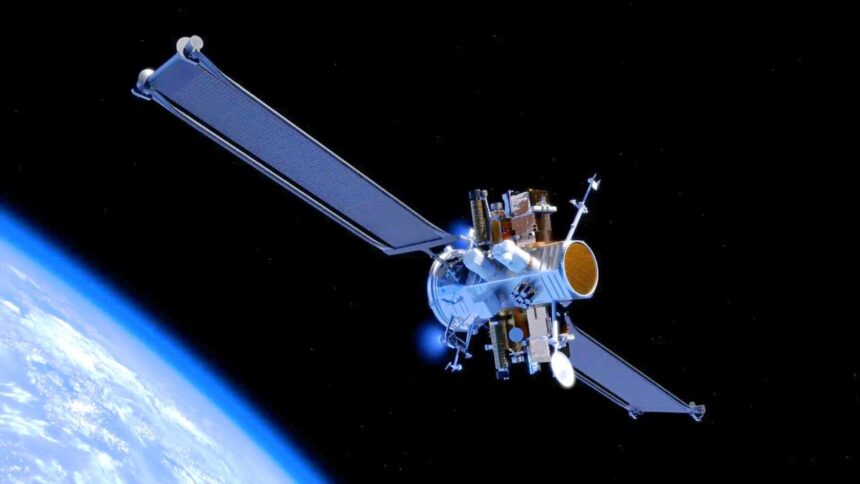Artificial intelligence and other technological trends are smoothing the way for commercial space ventures ranging from startups to multibillion-dollar companies.
It probably comes as no surprise that Blue Origin, the space company created by Amazon founder Jeff Bezos, is taking advantage of AI. “You can imagine this is a favorite area of our founder,” said Ariane Cornell, Blue Origin’s vice president of New Glenn strategy and business operations. “So, just generally, we are using it across the board.”
But other AI-fueled applications just might raise an eyebrow. For example, Rebel Space is helping satellite companies generate synthetic data that could point to a potential valve failure long before the spacecraft is launched.
“The AI you trained would see it, and you would prevent a massive mission failure in the future,” said Carrie Marshall, the startup’s co-founder and CEO.
Cornell, Marshall and other executives reflected on the trends accelerating the space industry this week during the Seattle Space Superiority Summit, presented on Thursday by FUSE VC at the Museum of Flight. AI figures in several of those trends. Here’s a breakdown:
National security needs
There’s a rising tide of interest in orbital transfer vehicles for a variety of applications, including satellite servicing and multi-satellite deployment. But capabilities that address national security concerns — for example, maneuvering a satellite out of harm’s way or challenging a threatening spacecraft — are among the biggest drivers behind that interest.
“There is a need to move over long ranges quickly in space that did not exist when space was not being considered a contested domain,” said Ian Vorbach, co-founder and chief operating officer of Bothell, Wash.-based Portal Space Systems. Portal’s Supernova space mobility platform is designed to address that need, with Pentagon backing.
Other companies working on in-space mobility include Blue Origin and Tukwila, Wash.-based Starfish Space. Blue Origin’s Blue Ring platform is due to fly its first mission next year, with an AI-enabled sensor built by Scout Space for the Space Force as the first announced payload. Meanwhile, Starfish Space is testing its second Otter Pup prototype in orbit, in preparation for a demonstration mission that could take place next year with Space Force funding.
The Trump administration’s plans for a missile defense system known as Golden Dome are likely to lead to more contracts for commercial space ventures, potentially focusing on in-space sensing and data processing.
“There are certain cases where the latency of sending stuff down, making a decision and going back out is probably not a very healthy or a very safe thing to have,” said Gareth Keane, a partner at the IQT venture capital firm (a.k.a. In-Q-Tel), which focuses on national security applications. “These are particularly in areas like the 200-plus billion dollars that we’re going to spend on Golden Dome.”
Space as a data frontier
In-space data processing will be valuable in fields that go far beyond national security. Nathan Stein, co-founder and founding scientist at Matter Intelligence, said it’s crucial for his company to winnow through the geospatial data that’s collected by his company’s space sensors while that data is still on the spacecraft.
“Instead of having to downlink hundreds of gigabytes of data for a single collect, can we produce Level 3 analytics products and directly downlink those, saving both cost and time?” he said. “For us, there’s just a direct correlation between how many images we collect and how much revenue you get.”
Another potential application involves shifting data centers from terrestrial locations to orbital spots where those power-intensive facilities can draw upon space-based solar power. Redmond, Wash.-based Starcloud is planning to test the concept with NVIDIA computer chips during a demonstration mission that’s due for launch as early as November.
Waiting for bigger rockets
Lots of space startups are looking forward to the ascendancy of SpaceX’s Starship super-rocket, which is currently under development and should be capable of sending more than 100 tons of payload into low Earth orbit. Blue Origin’s New Glenn rocket, which had its first launch in January and can put 45 tons of payload in orbit, will be a big contributor as well.
“In terms of competing with terrestrial data centers on energy costs, we are dependent on the launch cost coming down at least one order of magnitude,” Starcloud CEO Philip Johnston said. “When Starship or New Glenn or other launch vehicles come online, then we’re in a position to be able to move.”
Mike DeRosa, co-founder and chief marketing officer for Marysville, Wash.-based Gravitics, said he felt the same way about the prospects for getting its space station modules into orbit. “I’m so excited about the new vehicles that are coming online, and Stoke and [Rocket Lab’s] Neutron and New Glenn,” he said. “We’re in that fun place where we don’t want to leap forward, but we’re also like, ‘Oh, let’s get to next year when we can actually book a Starship launch.’”
There are also reports that SpaceX is working on a project known as Starfall, which would use Starship as a platform for in-space drug research and product development. That would represent yet another product line for SpaceX, which has already branched out from the rocket business with its Starlink satellite broadband network.
Andy Lapsa, co-founder and CEO of Kent, Wash.-based Stoke Space, said he’s not worried that Starship’s rise will hurt his own startup. “I’m excited about Starship,” he said. “I think a successful Starship helps this entire industry move forward. And I think it’s not a zero-sum game. At this point in the industry, a rising tide raises all ships.”
To the moon and back
NASA’s Artemis moon program is a multibillion-dollar opportunity for Blue Origin and other commercial space ventures. In 2023, a team led by Bezos’ space venture won a $3.4 billion contract from NASA to build a lunar landing system for crewed moon missions beginning as early as 2029. An uncrewed demonstration mission, involving Blue Origin’s Blue Moon Mark 1 lander, is said to be scheduled for next year.
Blue Origin is also working on a project called Blue Alchemist, which aims to extract materials from moon dirt and turn them into solar cells, construction materials and oxygen for lunar settlements. This week, Blue Origin said that the Blue Alchemist system successfully completed its critical design review.
Another Seattle-area company, Interlune, has its own plans to extract valuable materials from lunar soil. The startup’s first target is helium-3, which is more plentiful on the moon than it is on Earth and can be used in applications ranging from quantum computing to nuclear fusion.
“Our vision is really big,” Interlune co-founder and CEO Rob Meyerson said. “We want to put a fleet of five electric harvesters on the moon in the 2030s that’ll extract this helium-3 gas and bring it back to Earth.”
Down-to-Earth applications
Some space-centric companies plan to make at least some of their money down here on Earth. For example, Stoke Space has spawned a venture called BoltLine to commercialize the software platform it uses to track timelines for product development.
“I see it going further into areas of timekeeping as well as cost tracking, really giving us very accurate models for how much things cost — which could be utilized across the board, or if you’re developing satellites, or if you’re actually looking at how much it would cost to change frequency bands, change the type of hardware, any of those types of things,” said Kelly Hennig, Stoke Space’s chief operating officer. “And so I see that as being a very, very good opportunity for us to incorporate AI.”
AI also plays a big role in Amazon’s Project Kuiper satellite broadband network, which is scheduled to begin delivering service to customers by the end of the year.
“Kuiper is a software-defined network, and so AI can have huge productivity gains,” said Chris Weber, Amazon’s vice president of sales and marketing for Project Kuiper. “I’d say the single biggest thing outside engineering, software, etc., is the way we manage the network and manage capacity to provide a superior experience to customers.”
Project Kuiper’s main objective is to offer high-speed internet access to millions of people around the globe who are currently underserved, but Weber said he’s learning about use cases that he hadn’t thought about when he joined the Kuiper team 13 months ago.
“We just announced a deal with JetBlue,” he noted. “We’re very excited about how that’s going to be game-changing for anybody who’s had poor connectivity or inefficient connectivity on a plane. A couple of the new ones that I’m learning about, I’m still very clueless.”
For example, low-latency broadband access is a big deal for high-frequency market trading. “The amount of money people are willing to pay for every millisecond of performance advantage is huge,” Weber said.
Then there’s the golf circuit. “PGA Tour was interesting,” Weber said. “For every tournament, they lay down 40 miles of fiber. … So whether it’s us or others they look at, they can do a massive reduction in the efforts to get those tournaments. And you can take almost any remote sporting event, be they PGA or Formula One. All of them have the same issue.”
Read the full article here










